#Mary Queen of Scots: Queen Without a Country
Text

Mary, Queen of Scots: Queen Without a Country, France, 1553 by Kathryn Lasky (2002)
0 notes
Text

On November 29th 1512 the Auld Alliance was renewed between Scotland and France..
To mark the occasion, James IV, King of Scots, was presented with a 35-gun warship by the French ambassador, de La Motte.
Henry VIII was flexing his muscles and threatening war, he was feeling isolated after his break from the Catholic church, the king of Scotland, James IV, his brother in law was steadfast in keeping with the Catholic church, and so it was that France approached the Scots to renew their pact.
The "Historic Works of James IV. (1488-1513), King of Scotland wrote that......
"The 29th of November, this same year, [1512,] the ancient league and amity renewed and confirmed between the crowns of Scotland and France; at which time, the Lord ambassador de la Motte, from his master the French King, presents King James with a great ship of 35 pieces of ordnance, laden with wine and ammunition of all sorts, for war."
James IV liked his ships and out of all our monarchs I would say that he had the best navy.
Fast forward 46 years and James IV, and James IV had come and gone, Queen Mary was in France, and had earlier in the year married the heir to the throne, the future Francis II. Mary's mother Mary de Guise was ruling on her behalf in Scotland and on November 29th 1558 she called a parliament to strengthen the relations between the two countries.....again I refer to Historical works.....Mary (1542-1586), Queen of Scots....
"The Queen Regent calls a parliament at Edinburgh, the 29th day of November, this year, [1558,] wherein the French ambassador presents his master’s letter to the estates, which being read, and the priviliges of Scotsmen within the realm of France, ratified in parliament, with the act of naturalisation of each, [reciprocally,] of Scots in France, and French in Scotland, without more the parliament breaks up."
So the upshot was that any citizen of either country could settle in the country of their choice.
40 notes
·
View notes
Text
youtube
Mary, Queen of Scots - Romance & Betrayal (2023) | FULL DOCUMENTARY | HD
A Queen without a country, Mary Stuart remains one of the most memorable monarchs of Scotland.
She stood her ground against her cousin, Elizabeth I, and wasn’t afraid to rule from her heart.
Mary, Queen of Scots was an admirable woman of much influence in an era dominated by drama, turbulence, and disaster.
But what led to her execution? And why did she pose such a threat to Queen Elizabeth I’s rule?
Premiered 6 hours ago
23 notes
·
View notes
Text
Week 4: Exploring Edinburgh and Beyond with Family
This past week has been filled with excitement as I had the pleasure of hosting my parents in Edinburgh. Welcoming them to my familiar surroundings was a joyous occasion, allowing me to share the charm and beauty of this historic city that I now call home.
We kicked off their visit by embarking on a leisurely stroll around the town, revisiting the iconic landmarks that have become so familiar to me. From the majestic Edinburgh Castle perched atop Castle Rock to the vibrant and picturesque Victoria Street, every corner we turned held a story to tell. Of course, no tour of Edinburgh would be complete without a visit to the grand Palace of Holyrood, where we marveled at its regal splendor.
One thing my parents quickly learned about Edinburgh – and Scotland as a whole – is the unpredictable weather. Despite my dad's optimism about clear and sunny days, we found ourselves caught in a few unexpected rain showers. Yet, far from dampening our spirits, these rainstorms added to the allure of our adventure, reminding us that resilience and adaptability are key traits when exploring this beautiful country.
Venturing beyond Edinburgh, we embarked on a day trip to Stirling Castle, a place rich in history and significance. It was my second time exploring outside the bounds of Edinburgh, and I couldn't have asked for a more memorable experience. Walking in the footsteps of Mary Queen of Scots, whose birth and upbringing were intertwined with this fortress, filled me with a sense of awe and wonder. Despite the relentless rain and winds, we were transported back in time, immersed in the ambiance of centuries past. The history of Stirling Castle is as captivating as it is complex, and we spent hours delving into its storied past. From royal intrigue to tales of conquest and rebellion, every stone seemed to whisper secrets of bygone eras.
As the week drew to a close, I found myself grateful for the opportunity to share my love for Edinburgh and Scotland with my parents. Despite the occasional downpour, our adventures were filled with laughter, discovery, and cherished moments that will be fondly remembered for years to come.
And of course, here are the photos:





Talk to you guys soon!!
3 notes
·
View notes
Text
𝐒𝐓𝐀𝐓𝐔𝐒: Closed started for @thunyielding
𝐋𝐎𝐂𝐀𝐓𝐈𝐎𝐍: The Great Hall at Hampton court.
𝐃𝐀𝐓𝐄: November of 1559

Throughout the months spent sojourning at Hampton court, the Queen of Scots learned that her coats lined with fine ermine fur would do little to prevent the chill of England's November frost from creeping into her bones. The golden rays of France's Summer sun kept the glorious little jewel swaddled in eternal warmth—reinsuring both her comfort and radiance whilst serving as her husband's consort. It was her uncles that spearheaded her claim in this frost-laden country, those greedy statesmen who delighted in the idea of their young niece seated upon the throne of England where she might finally restore the TRUE faith in these godless lands. Two thrones would never be enough for the Guise when Mary shared the blood of several prominent European dynasties. More than anything, the Queen understood that her kin's greed would spell her family's destruction should they be blinded by their own toxic ambition.
Behind her strolling in perfect unison followed four young ladies bearing their queen's namesake, donning a similar shade of elegant crimson as their mistress. Before Mary had been delivered to France as Henry II's prize, the four Marys were chosen as the Queen's chief ladies in waiting. Together, the four women modeled themselves after the glittering image of the Virgin mother and sought to serve their holy mistress as confidants and servants whilst she flourished under the tutelage of both her mother-in-law as well as her grandmother Antoinette de Bourbon. Like Mary, her ladies were rigorously trained to exhibit nothing less than what was expected of French excellence despite their Scottish origin. If the Pope and her uncles meant to dominate this court with carefully crafted lies, then Mary would put her charms to work if only to ease the the blow of their corruption. A slight upturn of rosebud lips could enchant even the most sheltered of English hearts and that, Mary decided, was how she would win this freezing country to her cause. By hook or by crook, the English would EMBRACE their Scottish neighbor as they would their own.
Though she had been rather off put by the lack of attention shown to her by the Tudor King, Mary was determined to treat with his Boleyn relatives regardless of their sordid past, heretic faith, and distasteful Dowager. If she could not build a lasting rapport with the King, Mary would find an ally in his sister—the previous lady regent. In truth, Mary knew little of her cousin, the Princess of England. The occasional reports from the French ambassador to England hardly provided a provided a satisfactory description of Elizabeth's appearance and temperament. As always, the defiant Queen decided that she would meet her cousin on her own terms and without her uncle's ever cautious advice.
At first sight of England's precious diamond in the Great Hall of Hampton court, The Scottish Queen's four ladies simultaneously ladies sank into a low and tirelessly rehearsed curtsy as a sign of respect for her Highness—further exemplifying the prestige of good French breeding. Of course, Mary did not bow, for she was a Queen in her own RIGHT and needn't do anything except nod her auburn head at her cousin and lace a subtle smile along the surface of her pouty lips.
"My sweet cousin." She began, her voice ever warm and dulcet as her French lilt dominated her tone. "Too long have I waited to enjoy the company of my kin." Mary added as her eyes quickly scanned the stature of the Princess Elizabeth. The Queen could not help but compare herself to her cousin who stood nearly a foot shorter than herself but still bore their lineage's famed copper hair. Elizabeth was a Tudor through and through, and yet the glimmer of her Boleyn heritage showed proudly through several of her features. A slight wave of her hand sent the four Marys that smiled sweetly behind her away with another elegant curtsy. Like sparkling ORNAMENTS meant to be admired but not heard, her ladies would disperse and position themselves into important circles that would bring their queen good fortune in the form of Boleyn secrets. "Should time permit, I would like nothing more than to spend this eve with you."

12 notes
·
View notes
Text
The Death of Queen Elizabeth I of England and Ireland & the End of an era:


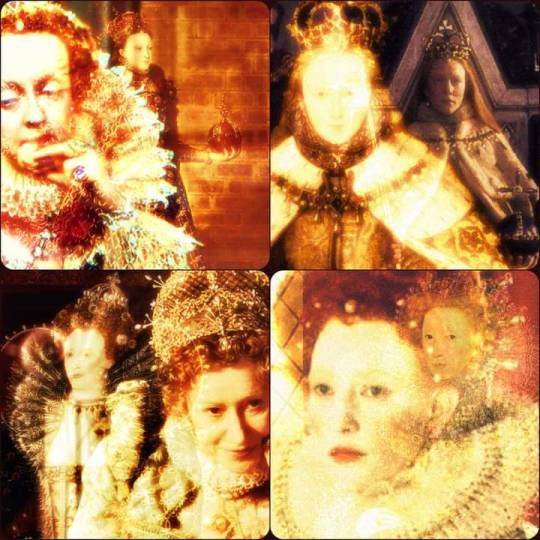
The last Tudor monarch died at Richmond Palace at the age of sixty nine on the 24th of March 1603 after ruling England for forty four years.
She was the longest Tudor reigning monarch, and third longest ruling Queen in English history. Elizabeth I was the daughter of Anne Boleyn and Henry VIII. Born on September 7th 1533, she was bastardized three years later following her parents’ annulment and her mother’s execution.
Out of all the monarchs, Elizabeth was unique in the sense that she never married. By refusing any marriage offer –while coyly entertaining every ambassador, making all sorts of promises that she would consider- she abstained herself from such troubles and was able to be her own mistress.
News of the Queen’s death spread like wildfire, also reaching her councilors’ preferred successor, James VI of Scotland. Weeks before on March 9th, Robert Cecil, son of her late and most trusted adviser William Cecil (Lord Burghley), wrote to George Nicholson, the English ambassador in Edinburgh, informing him that the Queen was ailing and that “her mouth and tongue” were “dry and her chest hot” and that she couldn’t sleep anymore. This is somewhat false. Elizabeth was deathly ill but she was far from helpless as Cecil’s report suggests. She was about her business, walking back and forth in her chambers, pondering on the future that awaited her country once she was gone.
Less than a week later, her condition worsened and she was no longer able to move as freely. Then on the 19th of March she gave a last audience to Sir Robert Carey (Mary Boleyn’s youngest grandson). She held Carey’s hand and confessed to him that she was not well. Sir Robert tried to cheer her up but to no avail. Elizabeth, as the rest, knew that her days were numbered and she wouldn’t live for another week.
On Tuesday, the twenty second she was brought to her bed where she stayed until her death. Her councilors visited her, insisting that she dictate her will so she could leave a successor but she refused. Like before, Elizabeth was always hesitant when it came to the issue of an heir. So many had competed for that position and so many were now gone.
Katherine Grey had married without permission and died nearly half mad in 1568, and ten years later her younger sister Mary Grey -who wasn’t allowed to see her husband because Elizabeth feared she could also produce children and rival claimants- and lastly, Mary, Queen of Scots who lost her head in 1587.
The favorite on everyone’s mind was James VI and one simple word from their queen’s mouth would give his claim even more validity but the Queen, probably not caring or in agony, remained adamant in her position. A story later circulated that Elizabeth I had indeed named James by way of her fingers when the council asked her to move her finger a certain way to mean that James was her successor and she did, but this cannot be corroborated and it is likely false.
The death of Elizabeth I marked the end of an era. A bloody, tumultuous era packed with religious and social change. She was not a staunch Protestant but she did push for Protestant reformer on the Church, primarily on the Book of Common prayer, and neither was she a Catholic –though one Pope expressed admiration for her, claiming that if she wasn’t a Protestant, he would support her instead of Philip II of Spain. Elizabeth was a moderate and she took a moderate approach. That is the type of monarch she was. Her laws were just as fierce, if not fiercer in some aspects, than her father’s, grandfather’s and siblings. The way in which she used her image says a lot about her. In one painting she is standing next to the goddess but if one looks closely it is the goddesses who are standing next to her, leading her to her destiny. Elizabeth was in popular eyes not just an anointed sovereign, but the head of all spiritual and earthly matters.
Read more here: https://tudorsandotherhistories.wordpress.com/2016/03/24/the-death-of-queen-elizabeth-i/
3 notes
·
View notes
Note
Do you think Philip marrying Elizabeth could've ever happened? Like I'm reading this Armada book and the guys saying basically it was happening since she really liked him as much as he liked her and got in trouble with Mary. But then she like wanted him to win her over more and wait but he took it as rejection so married another woman, but that it would've been real but idk politics got in the way I guess
I'm intrigued - could you tell me which Armada book you are reading?
The problem with them marrying was that Elizabeth could marry Philip only on his conditions, he required her conversion to Catholicism and England remaining Catholic (not only because of his personal faith and conviction but also because without these conditions there was no chance for him to get a dispensation from the pope to marry her which he needed because Elizabeth was his sister-in-law). These two moments were non-negotiable and at the existing conjuncture they were unacceptable to Elizabeth, as she famously put it to Feria, I can't marry your king because I'm a heretic.
The thing you mention about her wanting him to wait longer - I think I understand where it comes from. When Elizabeth found out about Philip's engagement to Elisabeth of Valois she commented to Feria that Philip:
could not have been so much in love with her as I had said, as you had not had patience to wait four months for her ; and many things of the same sort, as if she was not at all pleased at the decision adopted by your Majesty.
(See Feria to Philip, London, 11th April 1559. http://www.british-history.ac.uk/cal-state-papers/simancas/vol1/pp46-64)
This passage sometimes is interpreted exactly as you said, but it's far more likely that Elizabeth as other English was not pleased by this turn of events because they were worried about the prospect of alliance between France and Spain against England, let's remember that France championed the rights of Mary Queen of Scots (the daughter-in-law of Henri II, the French king) to the throne of England. Elizabeth knew about France-Spain antagonism and counted on the fact that Mary Queen of Scots becoming queen of England was an unacceptable scenario to Philip. On her accession and afterwards the situation was Elizabeth and Philip against France, Philip had supported her accession. Now, with Philip marrying Elisabeth of Valois and becoming son-in-law to Henri II, it seemed in England that Philip was abandoning his alliance with England, and him turning against England allied with France was the worst nightmare to the English. I can tell you that their concerns were not unfounded because Henri II indeed offered to Philip to go to fight England together but he rejected these offers. So he really didn't abandon Elizabeth even when married to Elisabeth of Valois (my boy!).
If Elizabeth had had a sudden change of heart that winter and had said like "hey whatever, I agree to be a Catholic" and married Philip, her Protestant friends, followers, supporters would have perceived it as a betrayal and probably she would have lost their support. But I don't think she would have lost her throne or power because a) England still was a Catholic country where Protestants were in minority; b) although Philip had become more unpopular due to the loss of Calais he had brains and resources to improve English opinion of him; c) there were actually people like English merchants in the Netherlands who supported this match.
And I think in certain circumstances Elizabeth may have married Philip, like if their marriage were arranged by their parents when they were in their teens (explored in this excellent AU fic) or if Philip and Mary had had a living child but Mary had died and Philip proposed to Elizabeth.
18 notes
·
View notes
Text

St. Giles Cathedral, Edinburgh, Scotland
During the group walking tour of Edinburgh, this cathedral stood sentinal over us as we walking up and down the main road. We came back to the end of this the tour and it was in the middle of a jumble of buildings. I tried to imagine it during its beginning days without all of the rest of the Old Town of Edinburgh surrounding it. Perhaps the most important thing to say about St. Giles is that it housed Protestant preacher John Knox (something I found interesting: he is the only person left in what used to be the graveyard and is now parking spot 23). John Knox was friends with John Calvin; after his exile and meeting Calvin, he came back to Scotland and preached there. St. Giles was stripped of all its Catholicism and began the Protestant reform with this. From the beginning of the reign of Mary Queen of Scots, Scotland was declared a Protestant country after having this cathedral labeled Catholic for over 400 years.
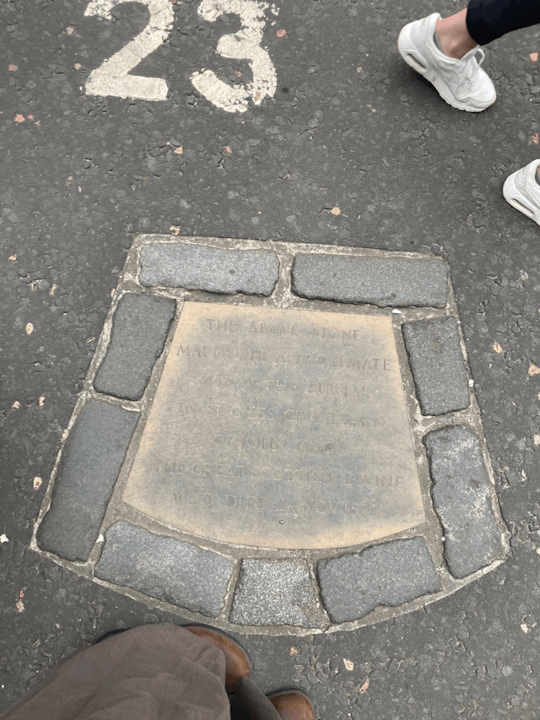
3 notes
·
View notes
Text
A Nerdy Presbyterian History Lesson

In 1603 James the VI, king of Scotland, also became James I, king of England. He did so because Queen Elizabeth I died without ever marrying nor producing an heir to the English throne, and James was the closest relative who qualified.
James happened to be the son of Mary, Queen of Scots, whom Elizabeth had imprisoned and eventually executed. To be fair, no love was lost between James and his mother. She was a staunch Catholic, and he was Protestant.
At the beginning of his reign, Scotland had a great deal of hope because James seemed to resist the urge to unite the two independent kingdoms under the camouflage of a common religion.
Scotland was Presbyterian, and England was Anglican—the former was much more egalitarian and less hierarchical than the latter, and the Scots kind of liked it that way. And it had been working for them for nearly 100 years because they had (by an act of Parliament) established their lay-led church government in 1560.
Then along came Charles I, the son of James, who assumed the throne after his father’s death and had none of his restraint. He introduced The Book of Common Prayer, which was to be used in worship by all clergy in every church in both countries.
Suppose you are wondering why I’m doing a whole history lesson with this Daily Devo. In that case, you need to know that in my former life, I was studying to become a professor of British history, which included a fair amount of Scottish history as well. So there.
Plus, I needed the background to tell the following story: Everything came to a head when in St. Giles’ Cathedral in Edinburgh, the minister began leading worship with the new prayer book, much to the dismay of the Scots in attendance.
A woman named Jenny Geddes picked up the stool upon which she was seated and threw it at the preacher, and a riot erupted in the middle of the church services. Worship was suspended for a week as a result.
A bronze copy of Geddes’ stool was presented by some forty Scotswomen to the Cathedral of St. Giles in 1992 and was presented with a poem by Iain Crichton Smith that has this line:
“And so she throws her stool at those who’d displace the thistle with the rose and bareness with exotic blooms, their arrogant imperiums.”
I love this so much. I love it because I have grown to love the Scottish people's fierce independence and because I happen to be Presbyterian. The thistle symbolizes Scotland, which is rugged, hard to hold, and beautiful. Not like those exotic English blooms.
And the Presbyterian form of church government, albeit with its own 16th-century issues, was empowering enough to the laity even then that a commoner and a woman dared to stand against hierarchy and oppression. So she chucked a stool at the compromising minister of her church.
I would hope that if I ever compromise my values, convictions, desire for justice, equity, mercy, and grace for all people, someone would chuck a stool at me. Just to remind me what I ought to be doing.
May it be so for all of us. And may the grace and peace of our Lord Jesus Christ be with you now and always. Amen.
0 notes
Text
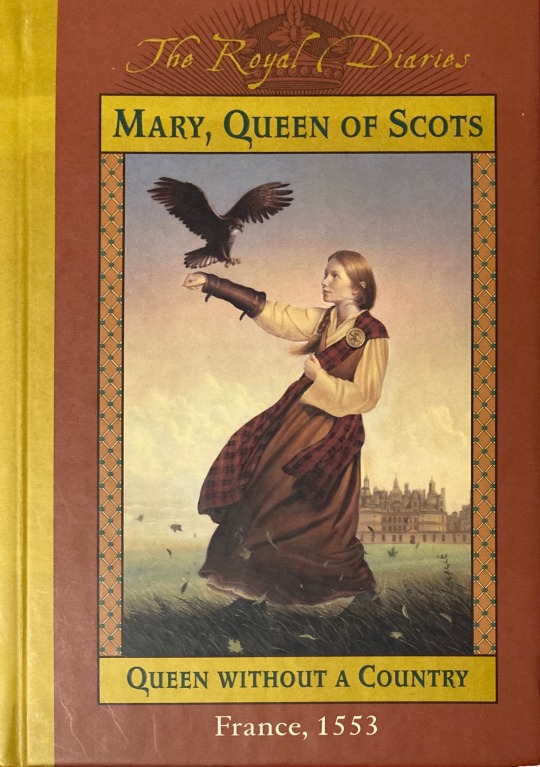
Mary, Queen of Scots: Queen without a Country, by Kathryn Lasky. Same author as wrote Elizabeth and they both mention each other. Does the word “queen” really need to be in the title twice?
Mary is only empathetic to people her age and a few select adults. Others she has no patience for, even when told why they might act the way they do.
Despite believing in the four humors, Mary’s understanding of medicine and the human body is not always accurate for her time. For example, knowing that blood circulates through the heart.
Goodreads star rating: 2/5
#mary queen of scots queen without a country#the royal diaries#mary queen of scots#mary stuart#france#scotland#1550s#kathryn lasky#book review#books
16 notes
·
View notes
Text
Mary Queen of Scots by Antonia Fraser
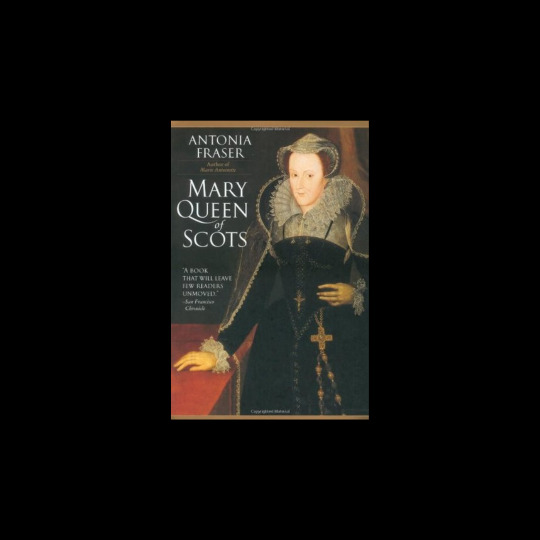
She was the quintessential queen: statuesque, regal, dazzlingly beautiful. Her royal birth gave her claim to the thrones of two nations; her marriage to the young French dauphin promised to place a third glorious crown on her noble head. Instead, Mary Stuart became the victim of her own impulsive heart, scandalizing her world with a foolish passion that would lead to abduction, rape, and even murder. Betrayed by those she most trusted, she would be lured into a deadly game of power, only to lose to her envious and unforgiving cousin, Elizabeth I. Here is her story, a queen who lost a throne for love, a monarch pampered and adored even as she was led to her beheading, the unforgettable woman who became a legend for all time.
#book rec list#book recommendations#Mary Queen of Scots: Queen Without a Country#mary queen of scots#mary i of scotland#scottish history
0 notes
Text

On December 26th in the year 1251 Alexander III, the King of Scots, was married to Margaret, the daughter of Henry III, King of England, in York.
Alexander hogs the limelight in posts about Scotland, giving his unfortunate accident and plunging the country into events that put yhe country into crisis for decades afterwards, so let’s tell you a wee bit about Margaret , who was our Queen for over 20 years, yet was only 34 when she died.
The second of five children, the first few years of Margaret’s life were spent quietly in the care of her affectionate and close family. Her first appearance in historical record came when she was three years old and she took part in a royal event in London with her brother, the future Edward I, yep the guy who would go on to inflict those years of strife for us Scots.
Margaret’s paternal aunt, Joan, had been married to King Alexander II of Scotland before she died in 1238 and so, as former brothers-in-law, Henry III and Alexander II had a good relationship and were quite fond of one another. When Alexander II welcomed the birth of a son with his second wife, Marie of Coucy, in September 1241 it was only natural that the possibility of a marriage between the young heir to the Scottish throne and Henry III’s eldest daughter be discussed. Margaret and Alexander III were betrothed when she was just four years old.
Alexander became King of Scotland at the age of seven when his father died in 1249 and Margaret became Queen of Scots at the age of eleven on thios day 1251, when she was officially married Alexander II at York Minster. The marriage was the third youngest of monarchs in the history of the British Isles.
Removed to the harsh climate of Edinburgh and kept quite separate from her husband Margaret became lonely and homesick, writing often to her parents about her poor treatment. This created tension between England and Scotland and it was not until 1255 that this was eventually settled and the young Queen was given an opportunity to reunite with her parents at Wark. The visit vastly improved Margaret’s spirits and she returned to Edinburgh feeling much revived.
In 1257 Margaret and Alexander III were held captive by the powerful Comyn family and it was only through the intervention of Margaret’s father and the regency council that they were freed. They went on to have three children: Margaret and Alexander, died as infants, and David born, 20th March 1272, and died June 1281. David’s unexpected passing left the couple without an heir, which had ramifications that resounded through the years.
Though her life was quiet there is some scandal which remains unresolved to this day. Margaret had in her employ a young courtier – given to her by her brother – who claimed to have killed her uncle, Simon de Montfort, 6th Earl of Leicester. One day, while walking with a group of ladies and courtiers along the River Tay Margaret is said to have become annoyed with the courtier and either pushed, or had him pushed, into the river. Playful laughter quickly turned to shock, however, when the man was swept to his death by the powerful current. Margaret was said to have been saddened by the event but we will never know exactly what part she played and how she truly felt.
Margaret died at the age of thirty-four on 26th February 1275 at Cupar Castle after falling ill while visiting Fife. She is buried at Dunfermline Abbey in Fife.
14 notes
·
View notes
Text
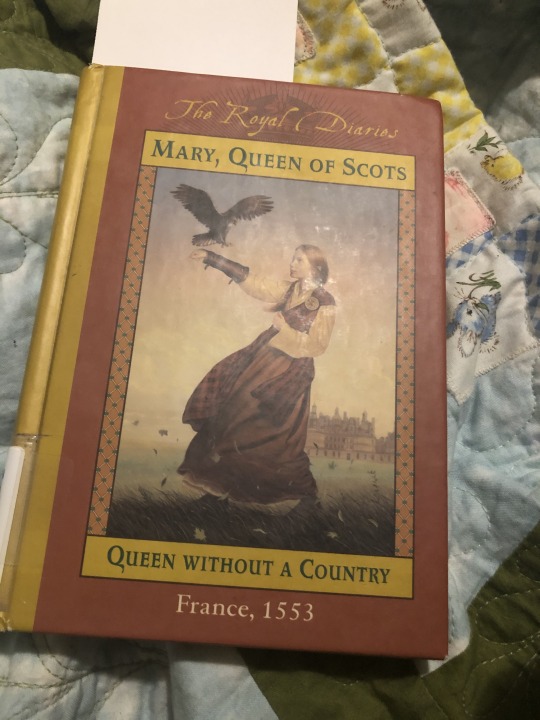
I finished the Royal Diaries of Marie Antoinette so now I’m onto Mary, Queen of Scotts. I’ve always been fascinated with Queen Mary so I’m interested in seeing how she is depicted in this representation.
#reading challenge#books#bookworm#currently reading#goodreads reading challenge#mary queen of scots#a queen without a country#the royal diaries
5 notes
·
View notes
Text
24 MARCH 1603: The Death of Queen Elizabeth I.

The last Tudor monarch died at Richmond Palace at the age of sixty nine after ruling England for forty four years. She was the longest Tudor reigning monarch, and third longest ruling Queen in English history. Elizabeth I was the daughter of Anne Boleyn and Henry VIII. Born on September 7th 1533, she was bastardized three years later following her parents’ annulment and her mother’s execution.
Out of all the monarchs, Elizabeth was unique in the sense that she never married. By refusing any marriage offer –while coyly entertaining every ambassador, making all sorts of promises that she would consider- she abstained herself from such troubles and was able to be her own mistress.
News of the Queen’s death spread like wildfire, also reaching her councilors’ preferred successor, James VI of Scotland. Weeks before on March 9th, Robert Cecil, son of her late and most trusted adviser William Cecil (Lord Burghley), wrote to George Nicholson, the English ambassador in Edinburgh, informing him that the Queen was ailing and that “her mouth and tongue” were “dry and her chest hot” and that she couldn’t sleep anymore. This is somewhat false. Elizabeth was deathly ill but she was far from helpless as Cecil’s report suggests. She was about her business, walking back and forth in her chambers, pondering on the future that awaited her country once she was gone.
Less than a week later, her condition worsened and she was no longer able to move as freely. Then on the 19th of March she gave a last audience to Sir Robert Carey (Mary Boleyn’s youngest grandson). She held Carey’s hand and confessed to him that she was not well. Sir Robert tried to cheer her up but to no avail. Elizabeth, as the rest, knew that her days were numbered and she wouldn’t live for another week.
On Tuesday, the twenty second she was brought to her bed where she stayed until her death. Her councilors visited her, insisting that she dictate her will so she could leave a successor but she refused. Like before, Elizabeth was always hesitant when it came to the issue of an heir. So many had competed for that position and so many were now gone.
Katherine Grey had married without permission and died nearly half mad in 1568, and ten years later her younger sister Mary Grey -who wasn’t allowed to see her husband because Elizabeth feared she could also produce children and rival claimants- and lastly, Mary, Queen of Scots who lost her head in 1587.
The favorite on everyone’s mind was James VI and one simple word from their queen’s mouth would give his claim even more validity but the Queen, probably not caring or in agony, remained adamant in her position. A story later circulated that Elizabeth I had indeed named James by way of her fingers when the council asked her to move her finger a certain way to mean that James was her successor and she did, but this cannot be corroborated and it is likely false.
The death of Elizabeth I marked the end of an era. A bloody, tumultuous era packed with religious and social change. She was not a staunch Protestant but she did push for Protestant reformer on the Church, primarily on the Book of Common prayer, and neither was she a Catholic –though one Pope expressed admiration for her, claiming that if she wasn’t a Protestant, he would support her instead of Philip II of Spain. Elizabeth was a moderate and she took a moderate approach. That is the type of monarch she was. Her laws were just as fierce, if not fiercer in some aspects, than her father’s, grandfather’s and siblings. The way in which she used her image says a lot about her. In one painting she is standing next to the goddess but if one looks closely it is the goddesses who are standing next to her, leading her to her destiny. Elizabeth was in popular eyes not just an anointed sovereign, but the head of all spiritual and earthly matters.
Read more here: https://tudorsandotherhistories.wordpress.com/2016/03/24/the-death-of-queen-elizabeth-i/
25 notes
·
View notes
Text
I've been thinking a lot about Jean Plaidy today and I've come to the conclusion that her greatest strength was also her greatest weakness: her speed.
Like this woman could write about 5000 words in a morning. And she churned out not only historical fiction across periods from Charles II to the Borgias to Queen Victoria to Mary Queen of Scots to George II, but also Gothic romance novels. I think this speed prevented her from allowing her historical novels room to breathe.
I'm not saying that novelists should only write about one period or one topic or one country and become experts. But I don't think it's a coincidence that the best historical novelists of the 20th century- Prescott, Graves, Irwin- were either professional experts or borderline experts of their period. (Though they wrote novels set in other periods.) And I think Plaidy just spread herself too thin, so instead of writing like 10 historical novels that are fully fleshed out, we have 50 historical summaries stuffed into novel format.
The thing with historiography I think is you can't just take it and microwave it and serve it. You need to think creatively and critically (though not to academic levels) and let it simmer and stew until the story you want to tell properly cooks. Maybe even make a primary source salad to go with it.
Plaidy did say that her historical novels was for an audience 'who want to learn something'. And that in itself isn't bad, but reading her I don't feel like I'm learning something but that I'm being Told Stuff. There's no meaning. There's no theme. Just This Happened And Then This Happened. Why is this event relevant to the plot? Why is this event relevant to the characters? Because it Happened. It is the story of their lives, so you get told what happened in their lives.
To her credit, across the course of her long writing career she does I think at least keep up with changes to the historiography. For example, in 1954 she wrote that Henry VII was secretly unbothered by the death of Elizabeth of York. But, in the blurb of a Plaidy novel about the couple that I found in a charity shop, published in the 70s, it is very obviously a love story.
I do get the sense that she didn't reread and edit and rewrite her work thoroughly. She said of her own writing that writing was like a drug, she wrote every day and if she didn't have a book in mind she'd get miserable. I wonder if this contributing to her churning out words without stopping to actually meditate on them.
Is this post me trying to reassure myself that my slow progress on my current projects is me 'not rushing'? Possibly
#historical fiction#i wish i had her speed#but also i dont envy her output#because what is the point of churning out pointless shapeless novels
16 notes
·
View notes
Text

I Know You’re Out There Somewhere 5
Gabrielle has been gone 6 months and now at 8 months pregnant Clara has made her slow down and lessened her workload, to 2 days a week. Sitting in her office and just doing minimal computer file work. At her last Dr. appointment, she was told that the baby was fine and progressing well, which made her happy. And was told to expect back aches and rest as much as possible. Her back has been hurting more and more and no amount of heating pads and soft pillows would ease the pain, the only thing would help was a nice warm bath, which she took nightly. Sometimes while relaxing her mind would wonder to Cordonia and Liam and her friends and how she just left, but she was pissed after Madeline showed up to her door the next day and said Liam proposed, she should have confronted him right then and there after Madeline left her room but she knew that’s what King Father and Godfrey wanted, they didn’t want an outsider, someone living from paycheck to paycheck to rule their country, hell maybe they thought she was a Crown chaser who wanted the rich life knowing that she would never want again and run the Country to the ground and go spend crazy and be a modern day Mary Queen of Scots, but she wasn’t like that, growing up not poor, but worked to get by she knew what it was like to go without, so she would have never been like that. She wanted to help and turn around the Country, Help the poor, and homeless and make sure all children had a warm home and adopted parents who loved them as their own, hell if it came to it, she would have talked to Liam about having them work at the palace, even if it were to clean the dungeons. But that’s all water under the bridge, she has a great job, a great place to live and is surrounded by beautiful co-workers.
The day after Bas left Leo’s Quarter’s with the information on Tariq being in the Sonoma Valley, Madeleine did some investigating into the area. Bas was nice but he did things old school, not relying on computer’s, he called in favor’s making other people do the work while he came out reaping the benefits, hell just about the only thing he was good for was his fighting skills. After some computer digging, she made a few calls to get her plan in motion.
Drake, Olivia and Maxwell were with Liam trying to help keep his mind from wandering to Riley, they convinced him to start eating more and drinking less, that his country was falling apart and needed their King back, Leo could do so much as King Regent, so with their help, meetings were made, charities were back to being cared for and the people were starting to rally around their King. He and Drake were in the gym more. Every time Liam wanted to drown himself in booze to rid his pain of Riley not being there, they were in the gym, either exercising or honing up on their fighting skills. “How ya holding up there Liam feeling better? I don’t want to wear ya out.” “Na man I’m good, I feel really good actually, thanks for this Drake it does really take my mind off things.” Sitting in the Sauna relaxing after a workout, Liam stretched out on the bench, Drake sitting with his head thrown back stretching his back, Liam turned to Drake with a look of guilt, he sighed softly.” Drake, I wanted to thank you for helping me get out of my funk, I know that you and Max and Liv and Leo and Bas have been helping in finding Riley, I know I should be helping too but I was just so caught up in my own self at her leaving and the stupid thing I did by kissing Madeline, but we were all so drunk, I’m not mad at her for kissing you,” “ Li I’m sorry man I didn’t know she was going to do that…” Liam held up his hand stopping Drake from going on. “I know man, I know but like I said I’m not mad at either of you, I was going to her room the next day to apologize after I woke up, but when I got there, she was gone. I found out what Madeline did that morning telling Riley that I proposed, I went to confront her, I went to her room and knocked on her door wanting to give her a real good tongue lashing for what she did, but when she opened the door, she crumbled at my feet with her head in her hands sobbing and telling me how sorry she was. I took in her disheveled appearance; I saw the honesty in her eyes.” He blew out a breath and shook his head. Looking back at Drake before adding more water to the stones. Drake raked his fingers through his hair. “Do you believe her Li? I mean come on its Madeline, we all know she’s as calculating and as cunning as they come, could have been another act? I mean …”
“ No Drake she was sincere, she never wanted the crown, she just joined the season because Regina and my father, (and I use that name loosely,) didn’t want her to get hurt like my mother did, which is bullshit to me but anyway yea I do believe her, she told me while we were on the tour she found someone with whom had his eye on her for some time, and they have been seeing each other when they could.” Drake’s eyes were wide while his jaw hit the floor… “Wait What? Are you serious?” “Yea she told me that the night we all went out to the beer garden, she was leaving Cordonia to go live with him and wanted to see where it could go.” “Wow Li just…. WOW. okay, care to share who?” “Um yea ya ready for this? Franchesco.
@ao719 @bebepac @the-soot-sprite @angryschnauzer @bobasheebaby @txemrn @dcbbw @queenrileyrose @kingliamandriley @hertzwritings @burnsoslow @ladyangel70 @fictionloveevie @kat-tia801 @sirbeepsalot @twinkleallnight @busywoman
8 notes
·
View notes